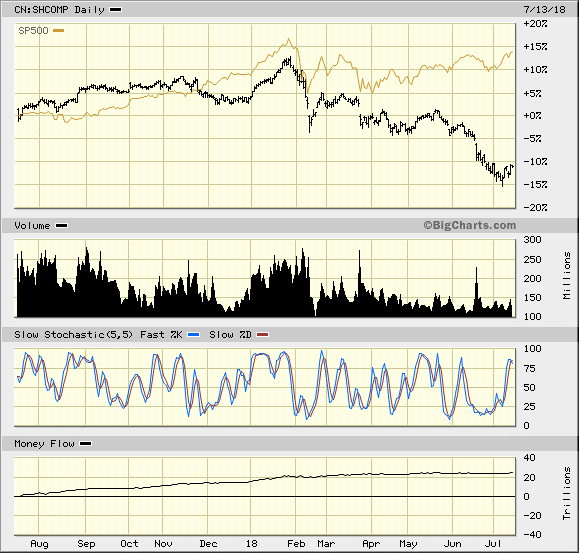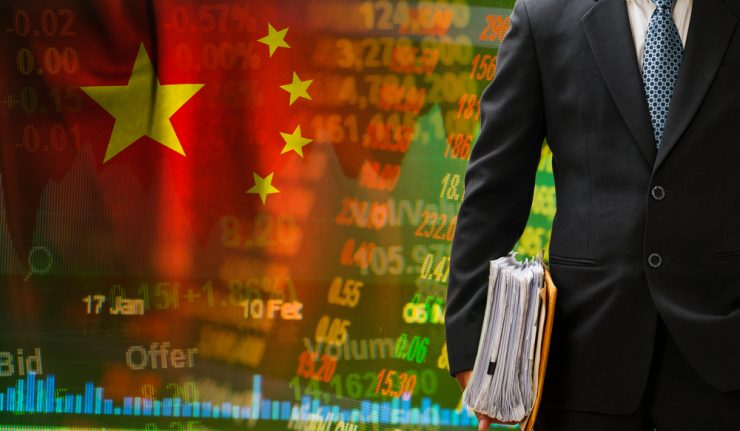The tale of the tape for both the Chinese and U.S. markets during the heated tariff skirmish is quite telling.
And since most investors are of the view that “the tape doesn’t lie,” it is revealing to see how the global market views the brewing trade war in terms of who wins and who loses. While both markets were clobbered back in February, when investors stepped back from stocks because of concerns that China’s economy was in danger of a major contraction, each country has taken a different direction since.
In the United States, rising bond yields, a spike in the dollar index and talk of the market being overvalued converged with fear of a slowdown in China. As a result, the U.S. market went down sharply.
The stock market decline at the start of February was swift and startling, a 10.16% fall in the S&P 500 over a nine-session span that ended on Feb. 8. This resulted in the market’s first correction — as defined by a drop of 10% or more — in two years. However, since then, the S&P 500 has stabilized and boasts a 4.78% year-to-date gain as of last Friday’s close.

Comparison of the S&P 500 (gold) and the Shanghai Composite Index (black). Source: BigCharts.com
Conversely, even though China’s government released data in mid-February confirming their economy remained on good footing, a brief snapback rally off the correction low in late February failed. Gradual selling pressure gave way to a sharp downward move in June and early July on tariff-related headlines.
When President Trump first announced China would be hit with tariffs on March 23, the Shanghai market broke down again. A couple of months of optimism then followed as a U.S. contingent brokered a deal for China to import as much as $200 billion more in American agricultural and energy products to help balance the trade deficit. Unfortunately, the business of combating Beijing’s misappropriation of U.S. intellectual property through joint venture requirements was never worked out or settled. As of today, this issue is the big elephant in the room that needs to be addressed.
Last Wednesday, world equity markets sold off in a knee-jerk reaction to the headline that the United States plans to place an additional $200 billion of tariffs on a variety of Chinese imports, bringing the total targeted amount to $250 billion, or roughly half of all Chinese imports. The news roiled investor sentiment after a four-day rally where the focus had returned to strong U.S. employment data and the upcoming second-quarter earnings season.
By definition, the current tit-for-tat tariff skirmish has yet to fully mushroom into a trade war, but it is moving in that direction. The final decision on the $200 billion of newly assigned import taxes will be sometime after Aug. 30, allowing for a good six weeks of negotiating time. Remember, though, that the genuine impact of an additional $200 billion in tariffs on Chinese imports amounts to only 0.1% of U.S. gross domestic product (GDP) growth. Also, the stock market seems to have priced in this potential eventuality already.
Although the macroeconomic impact of those tariffs can be seen as marginal, the trade measures likely could have a substantial cumulative effect, given the complicated nature of global supply chains.
“If you only focus on the $50-$250 billion in tariffs, the macro-impact is still very limited… The more worrisome news is more on the non-tariff parts, which is on investment restriction, and that could lead to a disruption in the global production line and also global trade,” Haibin Zhu, chief China economist at J.P. Morgan, told CNBC. “If you put them together, clearly the market is becoming much more nervous, and the nervousness is more severe in the onshore investor compared to the global investor.”
Although President Trump and Commerce Secretary Wilbur Ross are taking fresh heat from more skittish supporters and newly dubbed detractors, I believe they are operating from a position of strength. Trump and his team are, in my view, using the current leverage of a collage of variables to force China to succumb to change. China is stuck between a rock and a hard place, and the chart of China’s primary stock market is real-time evidence of an economy that could buckle if there is material disruption in the global supply chain that took 25 years to build. It is truly “Shanghai Noon” for the Shanghai Composite Index. A major violation of the 2,800 level will open the way for a further drop of 30% to 2,000, where the Index should find multi-year technical support.
Just as the Trump administration is highly sensitive to where the U.S. stock market is trading as a measure of confidence, I have to believe that China’s leaders are also watching their stock market closely, since further decline likely will rein in consumer spending. So, while China and the United States have each other by the shirt collars, I think if the Shanghai market falls below its current 2018 low of 2,691, we could see another trade summit scheduled sooner rather than later.
Markets can dictate policy if those in power want to remain in power. China’s highly leveraged financial system has been exposed and it is quite vulnerable to a sudden economic downturn, which the ruling Communist party and President Xi can ill afford. In short, this is why I think the Chinese will blink on trade and endeavor to clean up the nefarious practices that cost American companies hundreds of billions of dollars per year.
Money goes where it is best served, and that is currently the U.S. market. Along with China’s market meltdown, European markets are, for the most part, down for the year, as are Asian and Latin American markets. The U.S. dollar is king, inflation is tame and the domestic economy is set to grow by over 4% for the second quarter. Even though the prospect of a trade war provides an unknown impact on GDP growth, money flow from around the world still will find its way into U.S. markets for the foreseeable time. China may have some big long-term plans for global economic, military and political dominance, but the tale of the tape paints a very different picture — one of China’s leaders pridefully whistling by the graveyard.
The best path for investors to take at this time is to stay with a domestic focus. Specifically, a domestic focus within those sectors that are showing the strongest leadership, and by this I mean information technology and consumer discretionary. My Quick Income Trader service is producing monthly covered-call and naked put option income using stocks from these two outperforming sectors. Click here to see how I manage a stable of no more than seven income-producing strategies and keep one’s capital dedicated for income working overtime with the goal of generating 5-7% per month in cash flow. Just because you want to take a summer vacation doesn’t mean your portfolio should.




